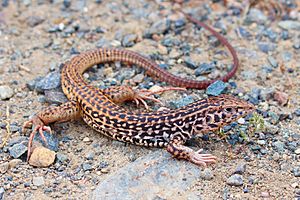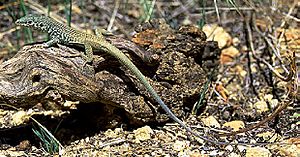Western whiptail facts for kids
Quick facts for kids Western whiptail |
|
|---|---|
 |
|
| California whiptail (Aspidoscelis tigris munda) | |
| Conservation status | |
| Scientific classification | |
| Genus: |
Aspidoscelis
|
| Species: |
tigris
|
| Synonyms | |
|
|
The western whiptail (Aspidoscelis tigris) is a type of lizard that lives in the southwestern United States and northern Mexico. You can find them in many different places, like deserts, dry shrublands, and even open forests near rivers. They prefer areas where there aren't too many plants.
These lizards are not considered endangered, and their numbers seem to be stable. They often live in burrows to stay safe and cool. The western whiptail used to be called Cnemidophorus tigris, but scientists changed its name after studying its evolution and family tree. Because they don't travel far, different types of western whiptails have developed in different regions. One example is the California whiptail.
Contents
What Does a Western Whiptail Look Like?
The western whiptail has a long, thin body. Its back is covered in small, bumpy scales, while its belly has larger, rectangular scales. Often, you'll see light stripes on its back. Adult lizards might have a pinkish or orange throat.
These lizards can grow up to about 10.2 centimeters (4 inches) long from their snout to the base of their tail. Including their tail, they can reach a total length of about 30.5 centimeters (12 inches). When they are newly hatched, they are orange-yellow with dark brown or black spots or stripes.
Where Do Western Whiptails Live?
Western whiptails are found across northern Mexico and the western United States. In the U.S., you can spot them in states like Arizona, California, Colorado, Idaho, Nevada, New Mexico, Oregon, and Utah.
They love hot, dry places, especially those with not a lot of plants. Their homes can be woodlands, chaparral (a type of shrubland), areas near rivers, or deserts. Whiptails that live in the desert often prefer areas with plants like sagebrush. They use burrows to escape the intense desert heat.
In the northern parts of their range, western whiptails usually come out of their winter sleep (hibernation) in May. Many adults then go into a summer sleep (aestivation) during the hottest months. However, in the southern areas, they are active from April through late August. This means they are active for a shorter time in the north.
What Do Western Whiptails Eat?
Western whiptails are mostly insect eaters. Their diet includes a variety of creepy crawlies like spiders, scorpions, butterflies and moths (called lepidopterans), crickets, grasshoppers, and beetles. They use their strong jaws to catch their prey, not their tongues.
How Do Western Whiptails Escape Predators?
When a western whiptail is attacked by a predator, it has a special trick: it can drop its tail! The muscles in the dropped tail will keep moving and flopping around. This helps to distract the predator, giving the lizard a chance to escape.
However, dropping their tail is a last resort for the lizard. It's very stressful for them and takes a lot of energy to grow a new tail. They also lose a lot of stored food when they drop it. This trick is often used when the lizard feels threatened by a house cat or a wild cat.
Different Types of Western Whiptails
There are 16 recognized types, or subspecies, of the western whiptail lizard. Each one has slightly different features or lives in a specific area. Here are some of them:
- A. t. aethiops
- A. t. dickersonae
- A. t. disparilis
- A. t. multiscutata
- A. t. munda
- A. t. nigroriens
- A. t. pulchra
- A. t. punctata
- A. t. punctilinealis
- A. t. rubida
- A. t. septentrionalis
- A. t. stejnegeri
- A. t. tigris
- A. t. vandenburghi
- A. t. variolosa
- A. t. vivida
Some of these subspecies are named after important scientists who studied reptiles. For example, dickersonae, stejnegeri, and vandenburghi are named after American herpetologists (scientists who study reptiles and amphibians) Mary Cynthia Dickerson, Leonhard Stejneger, and John Van Denburgh.



